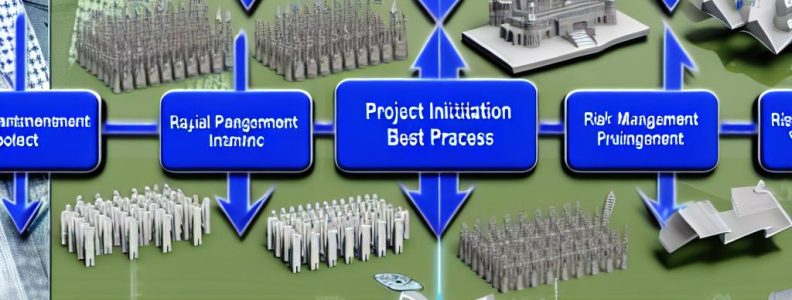Understanding PRINCE2 Project Initiation
PRINCE2, an acronym for Projects IN Controlled Environments, is a comprehensive, process-driven project management methodology that is well-known for its structured approach. The Project Initiation phase is pivotal within the PRINCE2 framework, as it lays the critical groundwork necessary for realizing a successful project outcome. This phase is where project objectives are clearly identified, the scope is established, and the roles and responsibilities of each team member are outlined in detail.
The Importance of Project Initiation
The Project Initiation phase within the PRINCE2 methodology is essential for ensuring there is a unified and clear understanding among all members of the project team. This stage is fundamentally important as it dictates precisely what the project will deliver and sets expectations upfront, significantly reducing the likelihood of misunderstandings or scope creep. By providing a strong foundation at the outset, the project team can work more effectively and cohesively, driving towards the desired outcomes with clarity and precision.
Key Steps in PRINCE2 Project Initiation
1. Develop a Project Brief: The initial step in the project initiation process involves the development of a Project Brief. This document serves as a high-level overview of the project, providing crucial details about the project’s justification, objectives, expected benefits, and alignment with strategic goals. The Project Brief is indispensable as it facilitates the authorization needed to advance to the detailed planning phase, marking the transition from initial concept to practical execution.
2. Define Project Approach: In this phase, project managers outline the appropriate methodologies, tools, and strategies to be employed in the delivery of project outputs. Selecting the right project approach involves thorough consideration of various constraints, including budgetary limitations, resource availability, and time constraints. Such thorough planning ensures that the project is approached pragmatically, enhancing the likelihood of meeting defined goals and objectives.
3. Prepare an Outline Business Case: The creation of an Outline Business Case is vital for understanding and articulating the project’s rationale. Within this document, the cost-benefit analysis is conducted to determine whether the anticipated benefits of the project justify the associated investment of resources and the inherent risks. This step ensures a strategic alignment of the project with the broader organizational objectives and helps in garnering the necessary buy-in from stakeholders.
4. Assemble Project Initiation Documentation (PID): The Project Initiation Documentation (PID) represents a comprehensive collection of all critical project plans, strategies, and governance requirements. Seen as a binding agreement between the project manager and the project board, the PID is instrumental in guiding the project through its lifecycle. It acts as a reference point that is revisited throughout the project to ensure adherence to plans and adjustment to any unforeseen changes or challenges.
5. Plan Quality and Risks Management: Essential to the PID are the quality assurance strategies and risk management plans. Quality assurance protocols define the standards and criteria for project deliverables, ensuring that the outputs align with client expectations and industry standards. Simultaneously, risk management plans identify potential risks, evaluate their impact, and propose mitigation strategies, enabling the project team to proactively address challenges.
Best Practices for Successful Initiation
Implementing best practices during the Project Initiation phase can significantly enhance the success of the project.
Engage Stakeholders Early: Early engagement of stakeholders guarantees that their needs, concerns, and expectations are thoroughly considered right from the outset. Such inclusivity fosters a sense of ownership and commitment among stakeholders, which can result in better support and reduced conflicts throughout the project.
Clear and Concise Documentation: Maintaining clarity and conciseness in all documentation is crucial in avoiding ambiguity and preventing any potential misinterpretations of project objectives or deliverables. Clear documentation forms the backbone of effective communication and facilitates a shared understanding among all project participants.
Continuous Review and Updates: The initiation phase should not remain static; it requires ongoing assessment and iterative updates to the Project Initiation Documentation (PID). Regular reviews ensure that the PID continues to reflect the evolving project environment and remains a relevant and practical guide throughout the project lifecycle.
Focus on Communication: Establish effective communication protocols early in the project initiation phase. These protocols ensure consistent and efficient information flow among team members and stakeholders. Regular updates, feedback loops, and open channels of communication play a crucial role in maintaining alignment with project goals and ensuring all team members remain focused on achieving the defined outcomes.
Conclusion
Project initiation within the PRINCE2 framework is an intricate, detailed process that plays a defining role in setting the stage for successful project execution. Following the prescribed steps in project initiation and adhering diligently to established best practices can result in superior management of projects and significantly improved outcomes. For those seeking more comprehensive insights into PRINCE2 project initiation, professional manuals or specialized courses provide valuable knowledge and understanding. Furthermore, exploring additional resources such as Axelos can offer guidance on PRINCE2 certifications and methodologies.

